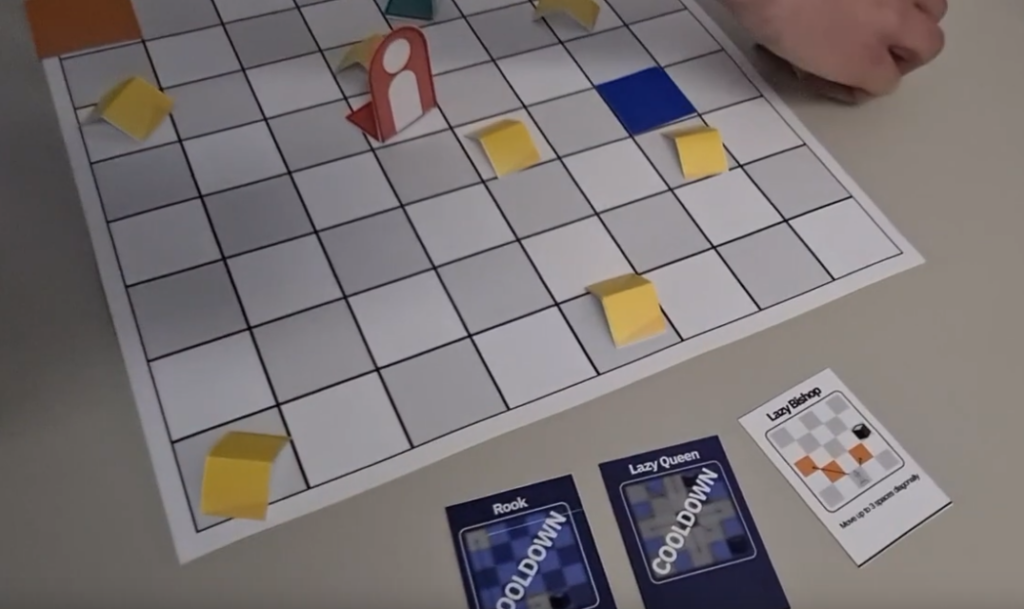DIY Chess

Overview
DIY Chess is a two-player game about balancing games. We created a set of cards that decide which moves a player can make. One of the players uses these cards to create two different decks, and the other player chooses which player plays with which of the decks. This requires the first player to really think the construction of the decks through, because if they create a deck that is significantly weaker than the other deck, there is a good chance that they will end up playing with that bad deck themselves.
My contributions
I was especially involved in the design (both of the general concept and the specifics like the cards) and the playtesting (leading some playtests and assisting in others). I also wrote the game rules and helped with the visual design of the cards. Later on, I directed and edited the explanation video.
Date/Period:
sep 2022 – dec 2022
Project type:
Student project
Tools I used:
Figma
Miro
Trello
Team:
Paul Brandstetter
Prineeth Ramachandra
Seah Oh
Thérèse Lundqvist
Result
Here is a more elaborate explanation of the rules:
The game components can be found at:
Process
Context / Goals
The problem we were presented with was that students Game Design starting their second year at HKU express a lack of confidence regarding their game design skills. The goal was to create a game that helps build this confidence.
Research
First, we did some general research on studies regarding confidence; why people might lack confidence and how to improve it. We also surveyed and interviewed some first and second year students on the topic, to confirm that the problem presented in the assignment actually existed and to talk about their takes on both the reason behind it and ways to improve it.
They confirmed that it indeed was a problem, which became especially apparent in group projects, because they felt like they, as Game Designers, had no special skills between the Game Artists and Game Developers.
This prompted us to create a game that focuses on a skill that is specific for game design (which we later decided would be balancing).
Concepting
The original idea was to create a digital game (probably a platformer), in which player 1 could adjust the player values (speed, jump height, gravity, etc.), after which player 2 could decide who would play the level. If they thought the level was doable, they should choose to play it themselves, and otherwise they should let the other player do it. If the player who played the level completed it, they got a point. Otherwise, the other player got a point.

Because of time constraints for creating the first version, we simplified the concept significantly for the prototype, which we created in Miro for remote testing. The idea was that player 1 would build the ‘level’ (in this case: place the obstacles), and player 2 had to choose who would play the game based on whether or not they thought it was possible to get from the bottom left corner to the top right corner with the given shapes.
There were several problems with this concept, the biggest being that it was immediately clear whether or not the level was possible. But we did see an interesting interaction between the players, shifting from discussing what would be best for the game and being competitive. This ultimately made us decide to make the game as a board game instead of a digital game.
Here you can see a second prototype. In this, we wanted both players to play the game, with each player having their own board and their own deck with allowed moves.
When we started fleshing this out further, we chose to use the different moves of chess, which made many players understand the game a bit faster.


Playtesting
During the creation of this game, we performed a lot of playtests in various phases of the process. We used surveys as well as our own notes to keep track of several things, so we could adjust the game accordingly. We looked at, among others, the clarity of the rules and the cards, players’ reactions (emotionally) to the game and the effectiveness regarding the actual goal.
This was the first game I worked on that really needed playtesting almost every step of the way, and I learned a lot about preparing for and running playtests. I learned more about when to intervene and especially when not to, and which questions to answer versus letting players figure it out for themselves.
